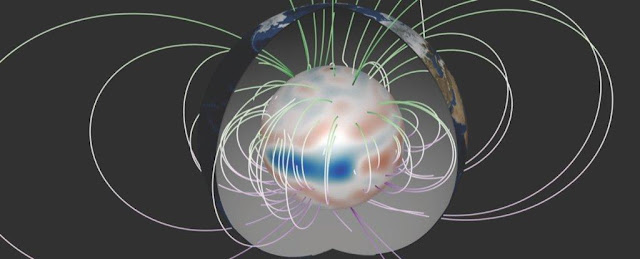The interior of the Earth is everything from peaceful. The world is teeming with activity deep below our surface, from plate tectonics to convection currents that move through the heated magmatic fluids deep beneath the crust.
Scientists have discovered something inside Earth that has
never before been observed through satellite data analysis: a novel kind of
magnetic wave that circles the surface of our planet's core every seven years.
This finding may provide light on how Earth's magnetic field
is created and reveal details on the thermal history and evolution of our
planet, or the slow cooling of the planetary interior.
 |
Visualization of the waves at the core-mantle boundary.
(Université Grenoble Alpes) |
Geophysicists have long postulated about the presence of
such waves, but their theories assumed that they occurred over considerably
longer time scales than what has been demonstrated by current study, according
to Nicolas Gillet of the Université Grenoble Alpes in France.
"Instruments located on the surface of the Earth that
detect the magnetic field indicated that there may be some sort of wave
movement, but we needed the worldwide coverage provided by observations from
orbit to clarify what is truly happening.
"To explain what the ground-based data had indicated,
we combined satellite measurements from Swarm with those from the earlier
German Champ mission and Danish rsted mission, along with a computer model of
the geodynamo, and this led to our discovery," the authors write.
For scientists, the magnetic field of the Earth is a source
of great intrigue. According to research to far, the invisible structure
creates a shielding "bubble" around our planet that keeps dangerous
radiation outside and the atmosphere within, promoting the survival of life.
However, the magnetic field is dynamic. It has
characteristics that we don't comprehend, changes in size, form, and strength
through time.
Because the magnetic field originates inside our globe,
internal activity is significant. It is produced by a dynamo, which is an
electrically conducting fluid that rotates, convects, and converts kinetic
energy into magnetic energy by spinning a magnetic field around the planet.
The molten iron in the Earth's outer core makes up the
majority of that fluid.
The Swarm satellites from the European Space Agency are a
trio of identical probes that were put into orbit in 2013 to research the
activity inside the Earth, with a focus on the magnetic and dynamic activity
coming out of the core. Gillet and his group found the intriguing new waves in
this data.
After that, they looked at information gathered between 1999
and 2021 by additional ground- and space-based observatories and discovered a
trend.
Large magnetic columns oriented along the Earth's rotational
axis, known as magneto-Coriolis waves, are strongest at the equator.
They migrate westward at a velocity of up to 1,500
kilometers (932 miles) each year and sweep around the border between the core
and the mantle with an amplitude of around 3 kilometers (1.86 miles) per year.
Due to a lack of data, we have not been able to discover
other magneto-Coriolis waves with other oscillation periods, but their
existence suggests that they may exist.
"Magnetic waves are likely to be triggered by disturbances deep within the Earth's fluid core, possibly related to buoyancy plumes," claims Gillet.
Our findings indicates that other similar waves are certainly possible, maybe with longer periods; however, their identification requires additional study.
For the time being, new discoveries could be utilized to
investigate the interior of our planet in novel ways, including the core, which
is challenging to research, as well as the core-mantle boundary. This is
because waves carry information about the medium through which they travel.
The team's research has been published in PNAS.
